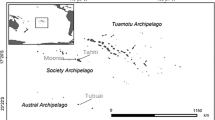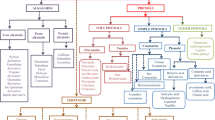Abstract
An isolated guinea-pig ileum preparation was used to screen for bioactive compounds from algae. 212 culture supernatants and methanolic extracts of randomly chosen marine and freshwater algae were tested for their effect on electrically evoked muscle contractions (recorded as a change in tension) and on the resting muscle tone. 15 out of 42 (35%) of the marine algae tested and 5 out of 64 (8%) of freshwater algae gave positive results. Of the 20 algae giving positive results, 6 had previously been shown to produce bioactive compounds (mainly toxins) but we can find no reports in the literature of bioactive compounds from the remaining 14. Of these 14 cultures, 9 were axenic and therefore production of the biological activity can be assigned unambiguously to the alga. These results confirm the usefulness of the guinea-pig ileum preparation as a screen for bioactive compounds from microbial cultures.
Similar content being viewed by others
References
Adelman WJ, Fohlmeister JF, Sasner JJ, Ikawa M (1982) Sodium channels blocked by Aphantoxin obtained from the blue-green alga,Aphanizomenon flos-aquae. Toxicon 20: 513–516.
Aune T, Berg K (1986) Use of freshly prepared rat hepatocytes to study toxicity of blooms of the blue-green algaeMicrocystis aeruginosa andOscillatoria aghardhii. J. Tox. Env. Health. 19: 325–336.
Berg K, Wyman J, Carmichael WW, Dabholkar A (1988) Isolated rat liver perfusion studies with cyclic hexapeptide toxins ofMicrocystis andOscillatoria (freshwater cyanobacteria). Toxicon 26: 827–37.
Biggs DF, Dryden WF (1977) Action of anatoxin I at the neuromuscular junction. Proc. West. Pharmacol. Soc. 20: 461–466.
Bishoff H, Bold H (1963) Some algae from Enchanted Rock and related algal species. Phycol. Stud. 4, Univ. Texas Publs 6318.
Cannell RJP, Owsianka AM, Walker JM (1988a) Results of a large scale screening programme to detect antibacterial activity from freshwater algae. Br. phycol. J. 23: 41–44.
Cannell RJP, Kellam SJ, Owsianka AM, Walker JM (1988b) Results of a large scale screen of microalgae for the production of protease inhibitors. Pl. Med.: 10–14.
Cannell RJP, Kellam SJ, Owsianka AM, Walker Jm (1987) Microalgae and cyanobacteria as a source of Glucosidase inhibition. J. gen. Microbiol. 133: 1701–1705.
Carmichael WW (1986) Algal toxins. In Callow JA (ed.), Adv. bot. Res. 12: 47–107.
Carmichael WW, Bent PE (1981) Haemaglutination method for detection of freshwater cyanobacteria (blue-green algae) toxins. Appl. environ. Microbiol. 41: 1383–1388.
Carmichael WW, Gorham PR (1978) Anatoxins from clones ofAnabaena flos-aquae isolated from lakes of western Canada. Mitt. int. Ver. Limnol. 21: 285–295.
Carmichael WW, Gorham PR (1974) An improved method for obtaining clones of planktonic blue-green algae. J. Phycol. 10: 238–240.
Carmichael WW, Biggs DF, Gorham PR (1975) Toxicology and the pharmacological action ofAnabaena flos-aquae toxin. Science 187: 542–544.
Carmichael WW, Biggs DF, Peterson MA (1979) Pharmacology of anatoxin-a produced by the freshwater cyanophyteAnabaena flos-aquae. Toxicon 17: 229–236.
Davio SR, Hewetson JF, Beheler JE (1985) Progress toward development of monoclonal antibodies to saxitoxin; antigen preparation and antibody detection. In Anderson DM et al. (eds), Toxic Dinoflagellates. Elsevier, New York, 343–348.
Gorham PR, Mclachlan J, Hammer UT, Kim WK (1964) Isolation and culture of toxic strains ofAnabaena flos-aquae (Lyngb.) de Bréb. Verh. int. Ver. Limnol. 15: 796–804.
Ishibashi M, Ohizumi Y, Hamashima H, Nakumura H, Hirata Y, Sasaki T, Kobayashi J (1987) Amphidinolide-B, a novel macrolide with potent antineoplastic activity from the marine dinoflagellateAmphidinium sp. J. Chem. Commun.: 1127–1129.
Jackim E, Gentile J (1968) Toxin of a blue-green alga: similarity to saxitoxin. Science. 162: 195–196.
Kellam SJ, Cannell RJP, Owsianka AM, Walker JM (1988) Results of a large scale screening programme to detect antifungal activity from marine and freshwater algae in laboratory culture. Br. phycol. J. 23: 45–47.
Kobayashi J, Ishibashi M, Nakamura H, Ohizumi Y (1986) Amphidinolide-A, a novel antineoplastic macrolide from the marine dinoflagellateAmphidinium sp. Tetrahedron Lett. 27: 5755–5758.
Kobayashi J, Ishibashi M, Walchi MR, Nakamura H, Hirata Y, Sasaki T, Ohizumi Y (1988) Amphidinolide C: The first 25-membered macrocyclic lactone with potent antineoplastic activity from the cultured dinoflagellateAmphidinium sp. J. Am. Chem. Soc. 110: 490–494.
Kogure K, Tamplin ML, Simidu U, Colwell RR (1988) A tissue culture assay for tetrodotoxin, saxitoxin and related toxins. Toxicon 26: 191–196.
Krebs HA, Henseleit K (1932) Untersuchungen uber die Harnstoffbildung im Tierkorper. Hoppe-Seyler's Z. physiol. Chem. 210: 33–66.
Lèfevre M (1964) Extracellular products of algae. In Jackson DF (ed.), Algae and Man. Plenum Press, New York, 337–367.
Mahmood NA, Carmichael WW (1986a) The pharmacology of anatoxin-a(s), a neurotoxin produced by the freshwater cyanobacteriumAnabaena flos-aquae NRC 525-17. Toxicon 24: 425–434.
Mahmood NA, Carmichael WW (1986b) Paralytic shellfish poisons produced by the freshwater cyanobacteriumAphanizomenon flos-aquae NH-5. Toxicon 24: 175–186.
Mahmood NA, Carmichael WW (1987) Anatoxin-a(s), an anticholinesterase from a cyanobacteriumAnabaena flos-aquae NRC-525-17. Toxicon 25: 1221–1227.
Mahmood NA, Carmichael WW, Pfahler MS (1988) Anticholinesterase poisonings in dogs from a cyanobacterial (blue-green algae) bloom dominated byAnabaena flos-aquae. Am. J. Vet. Res. 40: 500–503.
Moore RE (1982) Toxins, anticancer agents, and tumor promotors from marine prokaryotes. Pure & appl. Chem. 54: 1919–1923.
Park DL, Aguirre-Flores I, Scott WF, Alterman E (1986) Evaluation of Chicken embryo, brine shrimp, and bacterial bioassays for saxitoxin. J. Tox. Env. Health 18: 589–594.
Pennick NC, Cann SF (1982) Studies of the external morphology of Pyramimonas : 8.Pyramimonas gorlestonae sp. nov. Arch. Protistenk, 125: 223–240.
Reichelt JL, Borowitzka MA (1984) Antimicrobial activity from marine algae: results of a large-scale screening programme. Hydrobiologia 116/117: 159–69.
Ross MR, Siger A, Abbott BC (1985) The house fly: an acceptable subject for paralytic shellfish poison bioassay. In Anderson DM (ed.), Toxic Dinoflagellates. Elsevier, New York, 433–438.
Sawyer PJ, Gentile JH, Sasner JJ (1968) Demonstration of a toxin fromAphanizomenon flos-aquae (L.) Ralfs. Can. J. Microbiol. 14: 1199–1204.
Shilo M (1971) Toxins of Chrysophyceae. In Kadis S, Ciegler A, Aji S (eds), Microbial Toxins. Academic Press, New York, 67–103.
Shinohara K, Okura Y, Koyano T, Muraicami H, Omura H (1988) Algal phycocyanins promote growth in human cells in culture.In vitro Cellular & Developmental Biology 24: 1057–1060.
Spiegelstein M, Reich K, Bergmann F (1969) The toxic principles ofOchromonas and related Chrysomonadina. Verh. int. Ver. Limnol. 17: 778–783.
Taylor RF, Ikawa M, Sasner JJ Jr, Thurberg FP, Anderson KK (1974) Occurrence of choline esters in the marine dinoflagellateAmphidinium carteri. J. Phycol 10: 279–283.
Turell MJ, Middlebrook JL (1988) Mosquito inoculation: an alternative bioassay for toxins. Toxicon. 26: 1089–94.
Vonshak A (1986) Laboratory techniques for the cultivation of microalgae. In Richmond A (ed.), CRC Handbook of Microalgal Mass Culture. CRC Press, Boca Roton, Florida, 117–145.
Author information
Authors and Affiliations
Rights and permissions
About this article
Cite this article
Lincoln, R.A., Strupinski, K. & Walker, J.M. Use of an isolated guinea-pig ileum assay to detect bioactive compounds in microalgal cultures. J Appl Phycol 2, 83–88 (1990). https://doi.org/10.1007/BF02179773
Received:
Revised:
Accepted:
Issue Date:
DOI: https://doi.org/10.1007/BF02179773




